There was an interesting cosmology article in the Daily Telegraph last week. It was by science editor Sarah Knapton, and it was called Big Bang theory is wrong, claim scientists. I was pleased to see it, because in my humble opinion cosmology articles don’t feature in our newspapers enough these days. Clearly I’m not the only one who thinks like that, because as I speak there are 2,580 comments.
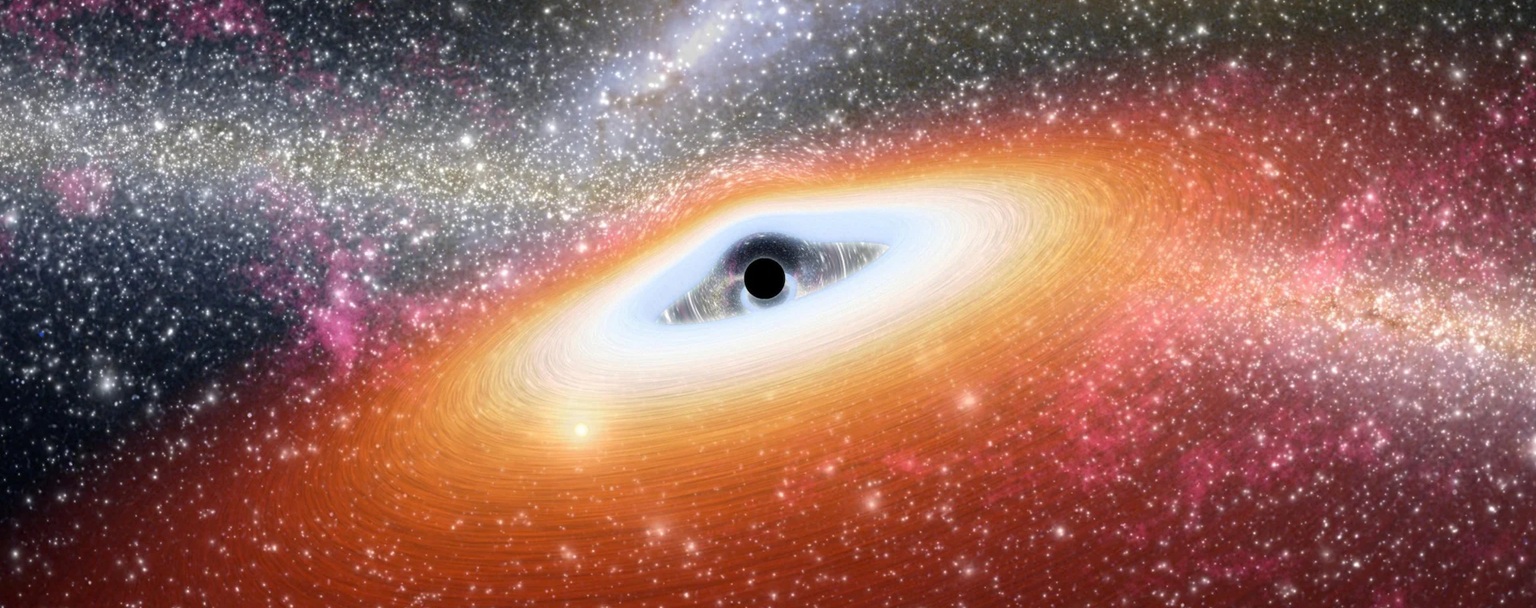 Image from The Daily Telegraph, caption: A black hole pictured by the Spitzer space telescope. Credit: AFP/Getty Images
Image from The Daily Telegraph, caption: A black hole pictured by the Spitzer space telescope. Credit: AFP/Getty Images
Oddly enough, the image heading up the story depicts a black hole, not the Big Bang. The caption suggests it’s a real image taken by Spitzer space telescope, but actually it’s an artists’s concept dating from 2010. But no matter, what matters is why is a black hole image heading up a Big Bang article?
The universe is sitting inside a black hole
The answer is in the very first line of the article: “The Big Bang theory is wrong and the universe is sitting inside a black hole, scientists have suggested”. At which point I sighed. Not just because scientists are saying Big Bang theory is wrong. But because they’re saying we’re living inside a black hole. There’s less evidence for that than there was for the four elephants and the turtle:
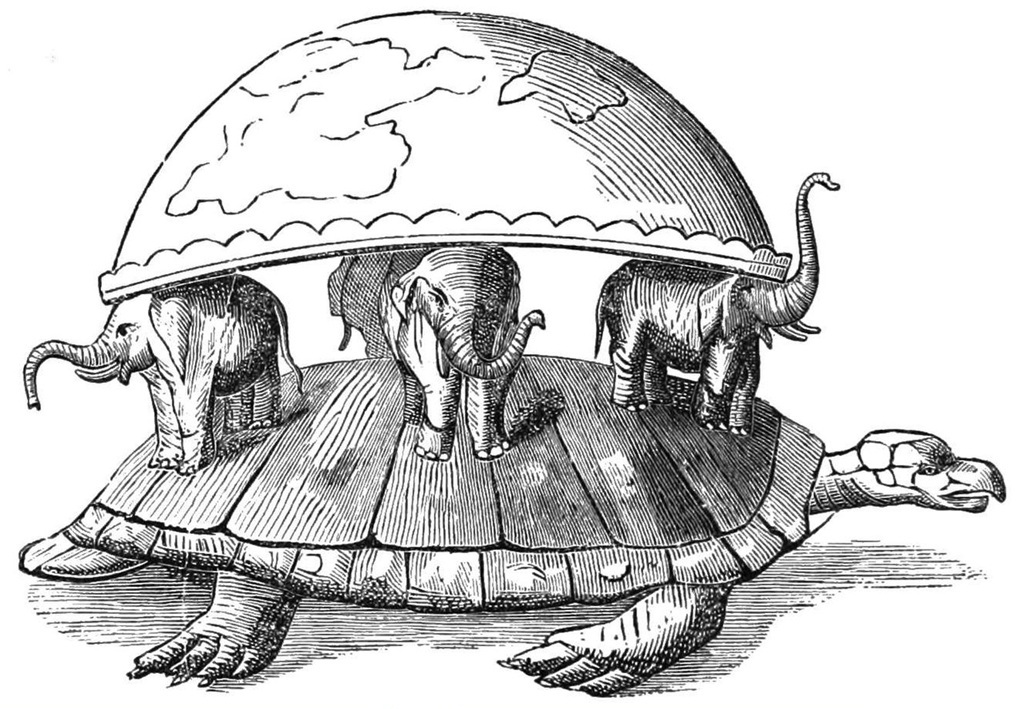 Public domain image from Wikipedia
Public domain image from Wikipedia
Regular readers will know what I think about the Big Bang. By 1917 Vesto Slipher had measured 21 galactic redshifts, Albert Einstein had written his cosmological considerations paper, and Willem de Sitter had come up with the de Sitter universe. A year later Erwin Schrödinger came up with his cosmic pressure. In 1924 Knut Lundmark came up with an expansion rate within 1% of measurements today. In 1927 Georges Lemaître wrote his French paper. In 1929 Edwin Hubble came up with A relation between distance and radial velocity among extra-galactic nebulae. In 1931 Einstein conceded that the universe wasn’t static, and Lemaître proposed the disintegration of the primeval atom. That was almost a hundred years ago. Since then the evidence indicates that the universe is expanding, and that all the galaxies were in essentially the same place 13.8 billion years ago. I’m happy with that.
Hawking likened the universe to a black hole in reverse
I wouldn’t say I’m happy with all aspects of Big Bang cosmology. I’m happy with much of it, like the Hubble expansion, the dark energy and the dark matter. But not all of it. For example I think inflation is a pseudoscience solution to problems that don’t exist: the monopole problem misses the point that the electron has an electromagnetic field, the flatness problem misses the point that homogeneous space is space without a gravitational field, and the horizon problem misses the point that the universe may have started with no temperature at all. In addition I’m not happy with a Big Bang point singularity. That’s because whilst I’m happy with the way Hawking likened the universe to a black hole in reverse, I don’t think there’s a singularity at the centre of a black hole:
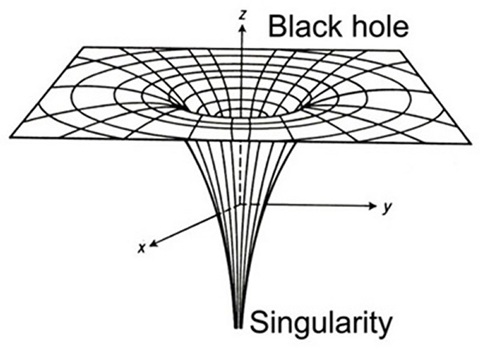 Image from Luke Mastin’s The Physics of the Universe. Quote: “in the centre of a black hole is a gravitational singularity, a one-dimensional point which contains a huge mass in an infinitely small space, where density and gravity become infinite”.
Image from Luke Mastin’s The Physics of the Universe. Quote: “in the centre of a black hole is a gravitational singularity, a one-dimensional point which contains a huge mass in an infinitely small space, where density and gravity become infinite”.
In similar vein I’m not happy with creation ex-nihilo. Or the way cosmologists used to say the universe was once the size of a grapefruit, but now say the observable universe was once the size of a grapefruit. Some now even say the universe has always been infinite. I don’t like that because I think the universe has to be finite to be able to expand. It’s the flip side of Isaac Newton’s infinite universe. All in all I think that whilst there are issues, Big Bang cosmology is essentially correct. You won’t find me promoting tired light theory. Au contraire, I’m the guy who will tell you the ascending photon is not redshifted, but is instead emitted at a lower frequency at a lower elevation, just like Einstein said. I’ll even tell you that the CMBR photons aren’t redshifted either, just like Tamara Davis said.
A variation of the Big Bounce hypothesis
Anyway, the Telegraph article refers to Lemaître, and says researchers have believed in Big Bang cosmology since the 1930s. Then it says this: “An international team of physicists, led by the University of Portsmouth’s Institute of Cosmology and Gravitation, has now suggested instead that the universe formed following a huge gravitational collapse that generated a massive black hole”. Portsmouth is an hour’s drive away from me. The Portsmouth University Institute of cosmology and gravitation (ICG) is headed up by Professor David Bacon, and has 65 staff. Among them is Professor Enrique Gaztañaga, who is quoted in this article. The story goes that the whole universe is contained within a black hole. Then we are told that matter within this black hole was “crunched down” before huge amounts of stored energy caused it to bounce back like a compressed spring, creating our universe. I’m sure we all recognise this as a variation of the Big Bounce hypothesis.
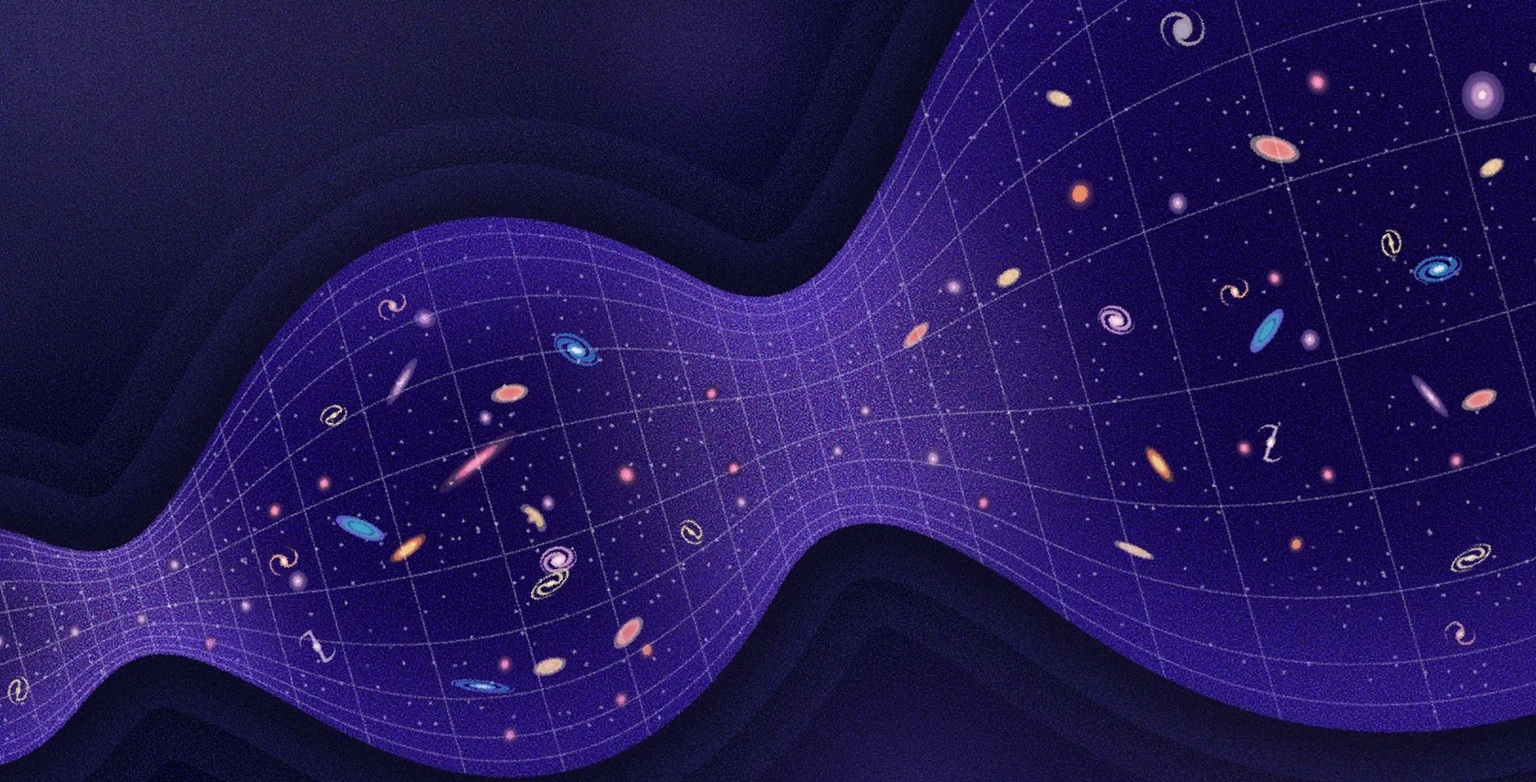 Image from Wired magazine, caption: In a cyclic universe, periods of expansion alternate with periods of contraction. The universe has no beginning and no end. Illustration: Samuel Velasco/Quanta Magazine
Image from Wired magazine, caption: In a cyclic universe, periods of expansion alternate with periods of contraction. The universe has no beginning and no end. Illustration: Samuel Velasco/Quanta Magazine
Check out the Wikipedia article on that. Note the bit that says “the so-called fundamental physical constants, including the speed of light in vacuum, need not remain constant during a Big Crunch”. Compare and contrast that with what Einstein said about the speed of light varying with gravitational potential. Also note that the Big Bounce hypotheses has been around since 1922. That’s when Friedmann wrote his paper On the curvature of space. It used to be called the Cyclic Model.
Chinese universes
However we are led to believe that the authors have come up with a new theory, where they claim that the edge of our universe is the event horizon of a black hole. The Telegraph article says this is why they’ve called it “The Black Hole Universe”. Only if you search the internet on that, you soon find a Space.com article called Is our universe trapped inside a black hole? This James Webb Space Telescope discovery might blow your mind. It dates from March 2025 and it was written by Robert Lea, who tells us that “the idea was first introduced by theoretical physicist Raj Kumar Pathria and by mathematician I. J. Good”. Check out the Wikipedia article on Black hole cosmology where there’s a reference to Pathria’s 1972 Nature paper The Universe as a Black Hole, and a reference to Good’s 1972 Physics Today letter on Chinese Universes. The Space.com article features theoretical physicist Nikodem Poplawski from the University of New Haven. It tells how in Poplawski’s theory, “the coupling between torsion, the twisting and turning of matter, and spin becomes very strong and prevents the matter from compressing indefinitely to a singularity”. It would seem that Poplawski has never read Friedwardt Winterberg’s 2001 paper Gamma ray bursters and Lorentzian relativity. That’s about the gamma ray bursts:
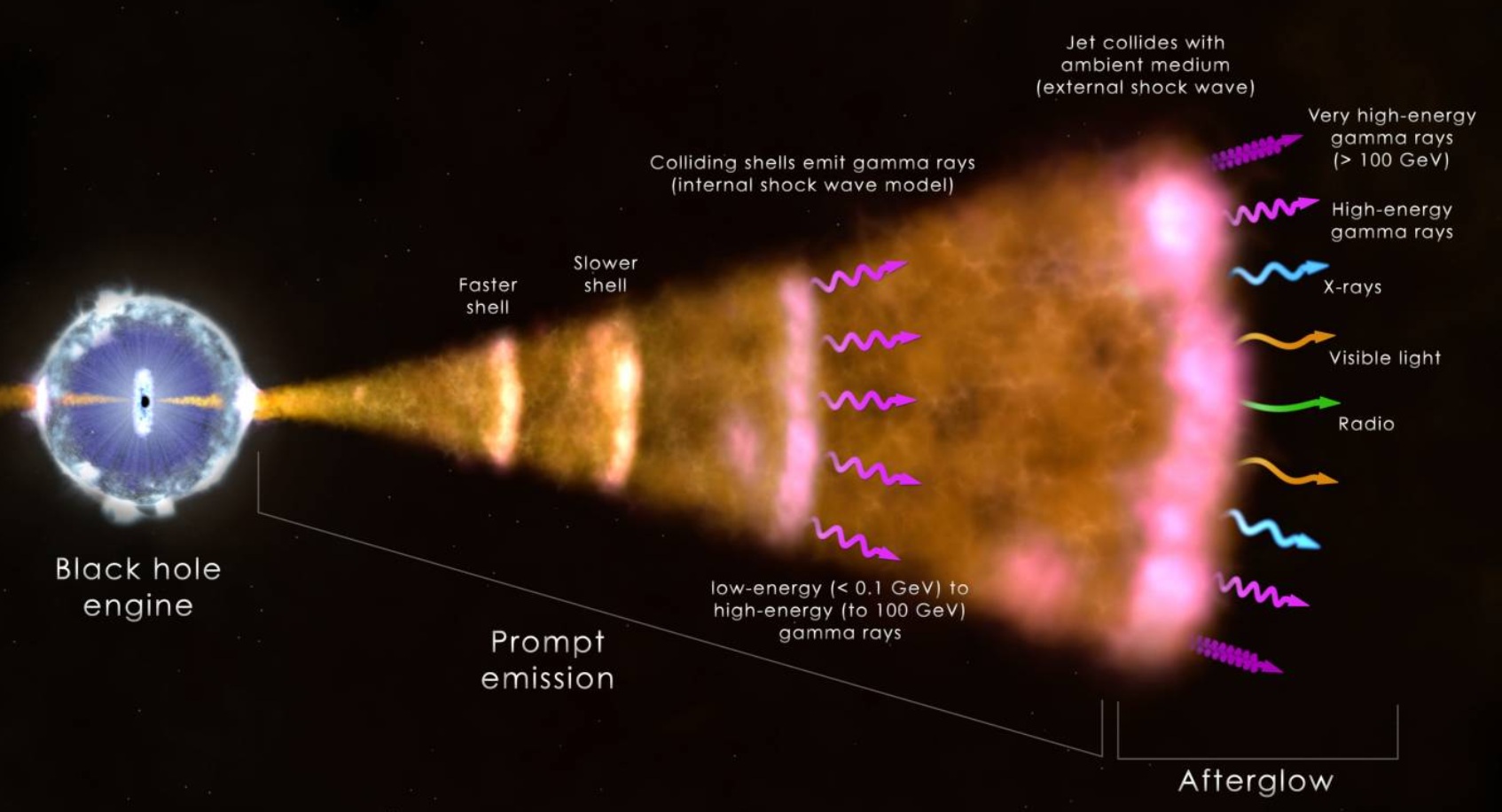 Gamma ray burst image from UCL see Cosmic explosions – detecting the highest energy light
Gamma ray burst image from UCL see Cosmic explosions – detecting the highest energy light
Poplawski is quoted as saying the matter stops collapsing, undergoes a bounce like a compressed spring, and starts rapidly expanding. He also quoted saying this: “Extremely strong gravitational forces near this state cause an intense particle production, increasing the mass inside a black hole by many orders of magnitude and strengthening gravitational repulsion that powers the bounce”. It would seem that Poplawski has never read what Einstein said in 1911, 1912, 1913, 1914, 1915, 1916, and 1920. Or much else, because strong gravitational fields do not cause particle production, because mass is a measure of energy content and energy is conserved, and because particle production does not result in gravitational repulsion. Sigh.
The bounce is inevitable under the right conditions
Back in the Telegraph article, we can read a quote by Professor Gaztañaga: “We’ve shown that gravitational collapse does not have to end in a singularity and found that a collapsing cloud of matter can reach a high-density state and then bounce, rebounding outward into a new expanding phase”. Could it be that Gaztañaga and Poplawski are co-authors? No they are not. Gaztañaga is also quoted saying this: “What emerges on the other side of the bounce is a universe remarkably like our own. Even more surprisingly, the rebound naturally produces a phase of accelerated expansion driven not by a hypothetical field but by the physics of the bounce itself”.
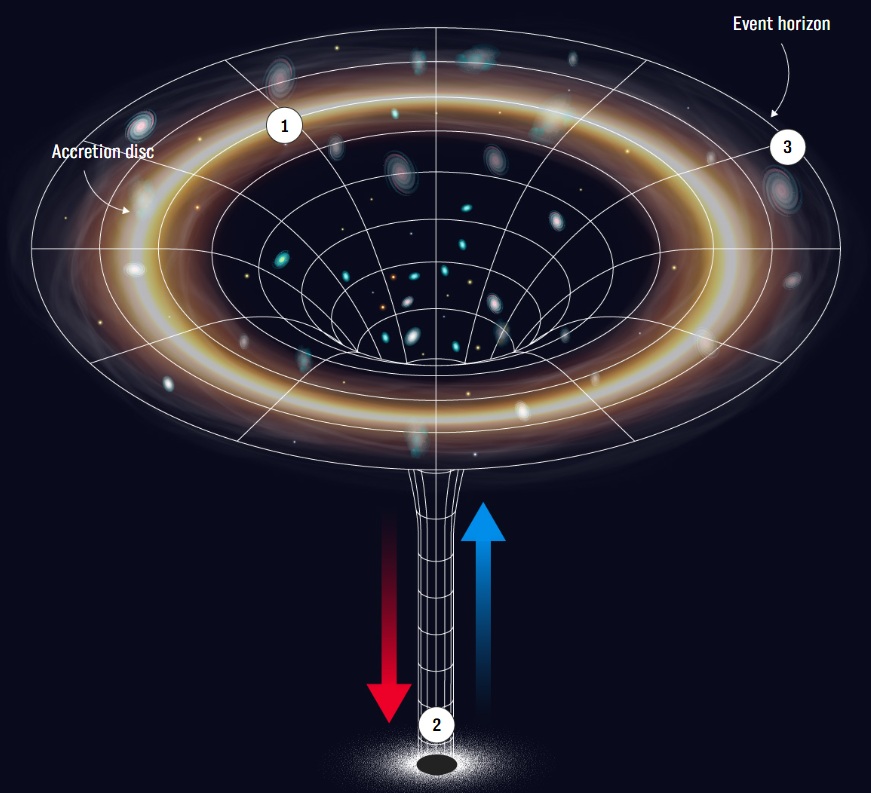 Image from The Daily Telegraph. Caption: 1: Accretion disc collapses to form black hole with matter crunched down to highly dense point. 2: Matter reaches max density, and bounces back forming universe. 3: The edge of the universe is actually the event horizon of a black hole, from which no light can escape
Image from The Daily Telegraph. Caption: 1: Accretion disc collapses to form black hole with matter crunched down to highly dense point. 2: Matter reaches max density, and bounces back forming universe. 3: The edge of the universe is actually the event horizon of a black hole, from which no light can escape
He goes on to say that he and his co-authors have a have a fully worked-out solution that shows that the bounce is inevitable under the right conditions. Inevitable under the right conditions is, of course, a bit of a cop out. If you didn’t spot that, try this for size: my rise to become leader of the free world is inevitable under the right conditions. But don’t hold your breath.
Defying quantum mechanics
It gets worse, because then comes the quantum mechanics. Apparently the new theory aligns with both general relativity and quantum physics. Which tells me that somebody else has never read anything by Einstein, and hasn’t heard Gerard ‘t Hooft saying quantum mechanics is nonsense. Not only that, but we gert the stupendous claim that “the Black Hole Universe also offers a new perspective on our place in the cosmos. In this framework, our entire observable universe lies inside the interior of a black hole formed in some larger ‘parent’ universe”. Oh boy. Apparently we are not special, we are not witnessing the birth of everything from nothing, but rather “the continuation of a cosmic cycle – one shaped by gravity, quantum mechanics, and the deep interconnections between them”. This isn’t just any old turtle. This is Cosmology and Gravitation turtles all the way down. What a pity that your average cosmologist wouldn’t know what quantum mechanics was if it jumped up and bit him on the arse.
Anomaly of galaxies’ rotation
The article goes on to tell us that recent JWST images showed that two thirds of galaxies were spinning clockwise, with the remaining third spinning anti-clockwise. One alleged explanation for this is that “the universe was born rotating, which would occur if it had been created in the interior of a black hole”. Sigh. And did you know that black holes cannot be seen “because of the strong gravity that is pulling light into the black hole’s centre”? Sigh. Or that each and every black hole could produce a baby universe which is connected to the outside universe by a wormhole? Sigh. Your average cosmologist has never read Einstein and Rosen’s 1935 paper on the particle problem in the theory of general relativity. Your average cosmologist doesn’t know how gravity works either. But no matter, you can read what they say in places like The Conversation, which bills itself as Academic rigour, journalistic flair. That’s where you can read about the “quantum exclusion principle”. That’s the Pauli exclusion principle to you. The one that only applies to fermions. The fermions that disintegrate in a gamma ray burst before they even make it to the event horizon. You can also read that “one of the strengths of this model is that it makes testable predictions. It predicts a small but non-zero amount of positive spatial curvature – meaning the universe is not exactly flat, but slightly curved, like the surface of the Earth”. What a pity WMAP found that space was flat in 2001, and Planck confirmed it in 2018.
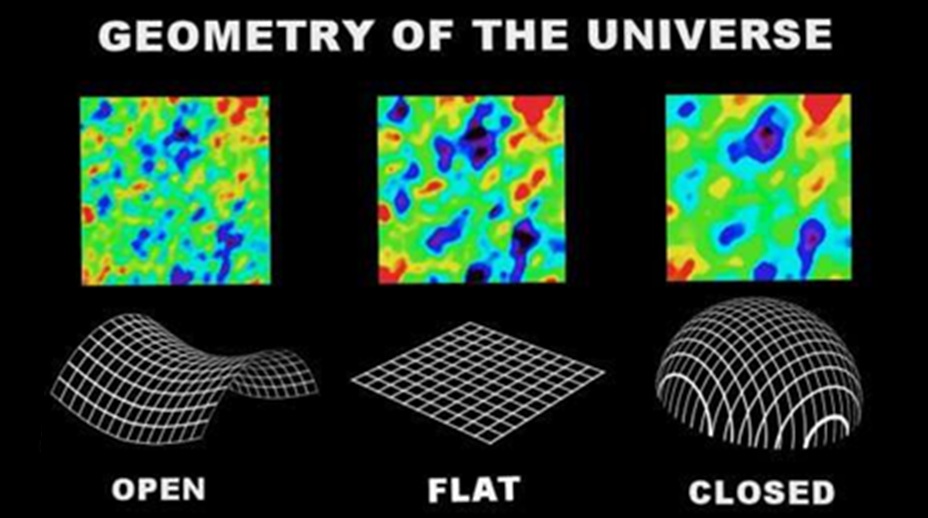 Image from the Phys.org article How do we know the universe is flat? by Fraser Cain
Image from the Phys.org article How do we know the universe is flat? by Fraser Cain
Of course it’s flat, because the electromagnetic field is curved space, not the gravitational field. See the Baez preliminaries article dating from 2006: “Similarly, in general relativity gravity is not really a ‘force’, but just a manifestation of the curvature of spacetime. Note: not the curvature of space, but of spacetime. The distinction is crucial”. And in case you didn’t notice, there is no overall electromagnetic field in the universe. By the by, Einstein said a gravitational field is a place where space is neither homogeneous nor isotropic, and modern cosmology says the universe is homogeneous and isotropic. Combine the two, and the universe has no overall gravitational field either. That’s why it didn’t collapse 13.799999 billion years ago.
Gravitational bounce from the quantum exclusion principle
The Conversation article is also given on the University of Portsmouth website. The paper concerned is Gravitational bounce from the quantum exclusion principle. It was published in Physical Review D on the 29th of May 2025. It’s paywalled, but you can read a preprint. It’s 21 pages, and it’s heavy on the maths, so you might find it tough going. So before you start, I recommend that you read what Einstein said about the speed of light varying with gravitational potential. Here’s an example: “a curvature of rays of light can only occur in a place where the speed of light is spatially variable”. You can find Irwin Shapiro saying much the same thing in 1964: “according to the general theory, the speed of a light wave depends on the strength of the gravitational potential along its path”. Now take a look at Einstein’s 1939 black hole paper. He said light rays “take an infinitely long time (measured in “coordinate time”) in order to reach the point r = μ/2”. That point is the event horizon. The descending light beam slows down, and then it stops. Because at the event horizon, the speed of light is zero. Then since a gravitational field is a place where there’s a vertical gradient in the speed of light and light can’t go slower than stopped, there is no gravitational field inside the event horizon. So there’s no gravitational collapse in there, and no gravitational bounce. The black hole wasn’t called a frozen star for nothing. It isn’t black because the gravitational field pulls back the upward light beam. It’s black because the speed of the upward light beam is zero.
Do we live in a world where the speed of light is zero?
All this is Einstein’s general relativity, and it constitutes a big problem for people who would tell you that the we live inside a black hole. Take a look around you. Do we live in a world where the speed of light is zero? No, we do not. So all of this stuff about the universe being some multiverse of Russian-doll black holes is just pseudoscience garbage. But sadly, too many science editors peddle this crap. Including the Independent, which is now only an online newspaper. Including the Times of India which says “the idea that our universe could exist inside a black hole is no longer confined to science fiction”. Only I am afraid, dear Times of India, that it is science fiction. The University of Portsmouth Institute of Cosmology and Gravitation has a research with us web page. Perhaps I should look into that.
 19th Century cat amongst the pigeons image, source unknown
19th Century cat amongst the pigeons image, source unknown
One of your worst articles. Poplawski’s work is much more interesting that you sell it to be. The reason it is connected with QM is because torsion naturally describes spinors. If you ever read Joy Christian’s work on bell correlations you’d know that torsion is also responsible for Bell violations, but nevermind that I know you think it is all just malus law. Torsion is an inevitable consequence of a 3-sphere topology, which in turn would be the topology of the universe if it came from a black hole.
.
You might know that the entirety of Maxwell equations can be simplified in one equation using geometric algebra (the Clifford algebra of 3D space), which naturally obeys the symmetries of a 3-sphere. The EM potential is none other than a measure of torsion (the more “space” is torqued, the higher the potential). Change the potential and you change the torsion, which mathematically can be simply be generalized by taking the symmetries of a 7-sphere. There’s just a very obvious reason why EM phenomena all have to do with rotation one way or another. It’s all just a bunch of coiled springs if you will, and coiled springs naturally allow for quantization (harmonic oscillators).
.
It’s particularly puzzling to me how you dismiss these works so easily when Einstein himself in his later years worked on tetrads, or vierbeins in German, to unify gravity and electromagnetism. Tetrads work by allowing a manifold to carry torsion. Hence the later generalizations of GR like Einstein-Cartan theory, which to this day remain criminally understudied.
Sandra, the Big Bang theory is certainly wrong. If you compare spiral galaxies with hurricanes, you will find that their structural forms are extremely similar. My research basically suggests that spiral galaxies are actually cosmic hurricanes, and this view can perfectly explain the spiral structure and flat disk morphology of galaxies, the formation and evolution of spiral arms, the origin of the huge angular momentum, and the warped structure of warped spiral galaxies. It is estimated that this view will soon be confirmed by astronomical observations.
.
If spiral galaxies are indeed cosmic hurricanes, it means that the cosmos has a large-scale background rotation, in which the Coriolis force drives the evolution of spiral galaxies. This would mean that the existing cosmological models need to be significantly revised, especially regarding the contribution of rotational parameters to the Hubble redshift. If the cosmos is spinning, the Big Bang theory is definitely a joke.
.
My work: Is the Spiral Galaxy a Cosmic Hurricane?
https://arxiv.org/abs/1802.02734
Noted, Cao. I suppose there is some similarity. Masses in motion often form spirals, and I suppose it doesn’t matter much why those masses are in motion.
Sorry, should I call you Cao, or Zexin? Chinese names give the family name first.
Calling me Cao is fine, Detective.
Morphological similarities are of course extremely important. If spiral galaxies evolve driven by Coriolis force, then not only is the density wave theory nonsense, but cosmological model must be completely different.
Thanks Cao. I think there’s a lot wrong with it. See what I said in The Standard Model of Cosmology is wrong on multiple counts. I am however happy with the expanding universe. I think of space as some kind of gin-clear ghostly elastic solid. A compressed ghostly elastic solid.
Detective, compare the similarities between spiral galaxies and hurricane images, and you may one day change your mind.


A hurricane is vorticial Cao. A whirlpool is vorticial too. So is an electron. So is a galaxy. I’m happy with that. I’m not so happy calling a galaxy a hurricane in space, but I don’t think it’s a ridiculous notion. Not like the notion that we live in a black hole.
I thought Cao was trolling at first, lol. It’s a nice paper Cao, but spiral galaxies have different rotational periods and directions and orientations, and of course this Coriolis force you talk about would effect the trajectories of everything else in the universe as well since according to this idea we are in this rotating reference frame. Any rotation at the rates you talk about has been well proved to not be the case decades ago.
Doug, you’re saying that the evidence is something I haven’t seen. Not every galaxy is driven solely by the rotation of the universe in its evolution. Each galaxy has its own unique mass distribution and rotational background, and their rotation periods and evolutionary patterns are naturally different.
.
If you’ve observed the morphology of warped spiral galaxies and the natural explanations we’ve provided, it’s highly likely that you wouldn’t agree with the ridiculous density wave theory. According to our theory, galaxies are no longer evolving in isolation, which means there must be a long-order variable. This long-order variable will inevitably affect the contribution to redshift and also influence the equations of the universe. The Big Bang theory will certainly be buried once again.
The arc-shaped ring outside the warped spiral galaxy NGC 5907 is probably a relic of the rotation of the entire disk of the galaxy.

That’s interesting Cao. I’ve never heard about tumbling galaxies before.
On another note, if you think the Big Bang theory should be buried, what do you think should replace it?
Cao, the images are similar. But if there was a cosmic Coriolis force then a comet’s orbit would clearly be affected by this Coriolis force and throw off our calculations of its orbit. So I think this strongly disproves your cosmic Coriolis force.
If the Big Bang theory is correct, the ratio of the old inertial force of 3.5 billion years ago to the present inertial force is 1.8 times.
Therefore. the old centrifugal force would be 1.8 times.
Did Cyanobacteria of 3.5 billion years ago live near the current position of Mercury?
Hideaki: apologies, your comment was in the spam folder. I can’t see why I’m afraid.
Sandra, I don’t have an issue with the notion of electromagnetic torque. You will notice that I talk of electromagnetism in terms of twisted space. But I must urge you to read the initial articles. Start with the nature of time, then progress to the speed of light, then how gravity works, then black holes. There is a simple chain of logic. A light beam curves downwards only because there’s a vertical gradient in the speed of light. A black hole is black only because the speed of light at the event horizon is zero. The crucial point to note is that light can’t go slower than stopped, so there is no gradient in the speed of light within the black hole. Hence there’s no gravitational force in there, and no collapse towards a point singularity. So there’s no bounce before the point singularity. On top of that, gamma ray bursts are a matter of fact, and I think Winterberg was right when he said fermions are destroyed before they reach the event horizon. That’s because an electron falls faster and faster, and would end up falling faster than the local speed of light. That absolutely can’t happen, because the electron is light in a closed path, like Schrödinger and other quantum realists said.
The irony of course is that gamma ray bursts are what reawakened interest in General Relativity and led to the “golden age” where people like Wheeler, Sciama, Penrose, and Hawking ignored just about everything Einstein said and made it up as they went along. Poplawski takes it further. Extremely strong gravitational forces do not cause an intense particle production. Particle production does not increase mass “by orders of magnitude” or result in gravitational repulsion. There is no such thing as gravitational repulsion, and none of the above has got anything to do with creating a universe. The guy is a total bullshitter. I’m surprised you’ve fallen for it.
Please don’t. Instead try to understand the issues with what he’s claiming. If I can assist you in stepping through the articles to gain an understanding of gravity and black holes, please don’t hesitate to leave relevant comments. Apologies in advance for the links that no longer work. I will endeavour to fix them.
Detective: I don’t really think you even understand how Einstein field equations work, what a connection is, or differential geometry in general. You’ve been pushing this holistic view of yours for years yet you’ve never bothered to look up the details of your own theory. You also like to twist historical facts to conform to your views, and have the courage to disparage brillian minds like penrose, sciama, poplawski and wheeler, while you yourself only wish you could have made contributions like theirs. Moreover, when presented with counterarguments, you parrot the same trite non-answer to every argument: like above, you did not even aknowledge any of my points. I’m not sure sure whether this is delusion at work, or simply dishonesty.
.
To adress one of your points, unlike what you do: gravitational repulsion is, mathematically, equivalent to torsion in poplawki’s work. It’s supposedly the source of the pauli exclusion principle, characteristic of all particles with SPIN. You don’t seem to have a problem with “counter rotating vortices repelling themselves”, so what gives?
Sandra: I understand it. This “holistic view” is not mine. It was Einstein who said repeatedly that the horizontal light beam curves downwards because there’s a vertical gradient in the speed of light. See the quotes from 1911, 1912, 1913, 1914, 1915, 1916, and 1920. I haven’t twisted historical facts. Einstein said what he said. If you prefer to disregard Einstein, and Shapiro, and Don Koks the PhysicsFAQ editor, take a look at the evidence instead. For example, NIST optical clocks go slower when they’re lower, and there is no such thing as “time” flowing through them. These clocks go slower when they’re lower because light goes slower when it’s lower. Which means the ascending light beam speed up. Which means people like Penrose, Sciama, Poplawski, and Wheeler got it wrong. They are giving you an ersatz version of Einstein’s general relativity. One which conflates the local speed of light (which is measured to be constant because of the wave nature of matter) with the global speed of light. As for counterarguments and addressing your points, that’s exactly what I did. The important thing to note is that fermions don’t get through the event horizon, and are destroyed in a gamma ray burst. See my Firewall! article. Another important point is the lack of a gravitational gradient inside the event horizon. There’s no delusion or dishonesty on my part, but there is a great deal of research.
Re your final paragraph: “To address one of your points, unlike what you do: gravitational repulsion is, mathematically, equivalent to torsion in Poplawki’s work. It’s supposedly the source of the Pauli exclusion principle, characteristic of all particles with SPIN. You don’t seem to have a problem with “counter rotating vortices repelling themselves”, so what gives?”
What gives is that gravity is a trace force, or a residual force if you prefer. It has an electromagnetic nature because it’s associated with a gradient in c = 1/√(ε₀μ₀), but it is circa 10⁴⁰ weaker than other electromagnetic forces, see hyperphysics and my reply to Greg. In addition gravity is always attractive. It does not repel. You would appreciate this if you understood how gravity works. It’s essentially a downward refraction of the horizontal light beam, wherein the wave nature of matter means a particle like an electron is in essence light in a closed path. The horizontal component bends downwards, and as a result the electron is displaced downwards. Not upwards. So whilst I might liken the Pauli exclusion principle to the way two whirlpools cannot overlap, that repulsion is a far more powerful than gravitational attraction, gravity is never a repulsion, and it isn’t a torsion either. Then since there are no fermions inside a black hole, and no gravitational gradient either, Poplawski’s theory just doesn’t fly, no matter what the mathematical equivalence might be.
In closing, can I say that people like to believe in magical mystical things like spooky action at a distance and a Russian-doll black hole multiverse. Scientists are not immune to this. They too believe in such things. Sometimes with total conviction. So very total that they absolutely will not pay attention to the empirical scientific evidence that shatters those convictions. But I’m afraid those magical mystical things are just woo, Sandra. Sorry.
> The irony of course is that gamma ray bursts are what reawakened interest in General Relativity and led to the “golden age”
&/n;
&/n;
Did you mean quasars? If not can you give a source?
Well, I wouldn’t want to rule them out, because quasars were discovered first, as radio sources. But I did mean gamma ray bursts. See this from the Wikipedia article: “GRB signals were first detected in 1967 by the Vela satellites, which were designed to detect covert nuclear weapons tests; after an “exhaustive” period of analysis, this was published as academic research in 1973″.
Sandra, I am confused why you believe Christians work when there are papers refuting his work and more importantly, after more than a decade there still has not been a computer program made that could even simulate beating the classical limit in the CHSH game without non local effects.
.
I started reading the introduction to Christians paper which starts by saying the entanglement experiments showed that you have to give up realism, locality, or both. Which is wrong, you have to give up locality, realism you can choose to keep if you want.
John, you state that you don’t currently think there is an electromangnet strong force governing expansion. I agree.
What about the known electromagnetic strings/filliments that are mostly accepted as real phenomena? I think they are remnants of an ancient electromagnetic process simular to topics at hand.
What thinks you, Sir ?
Greg: I think the strong force is electromagnetic in origin. I think it’s the spatial curvature of a photon that confines that photon in a chiral “trivial knot” configuration called an electron or a positron. Or in a chiral “trefoil knot” configuration called an antiproton or a proton. These are the only stable massive particles, and IMHO they move towards one another, or away from one another, and around one another like counter-rotating and co-rotating vortices. The linear component of this motion is labelled electric force, and the rotational component of this motion is labelled magnetic force. When opposite linear forces balance but rotational forces do not, we say a magnetic field is present. When opposite rotational forces balance but linear forces do not, we say an electric field is present.
I also think the nuclear force is electromagnetic because electron capture does what it says on the tin, and the neutron charge distribution exactly matches the nuclear force profile. On top of that I think gravity has an electromagnetic nature because it’s associated with a gradient in c = 1/√(ε₀μ₀). It would seem to be a “residual” force. Something that’s still there when the linear and rotational electromagnetic forces balance, because when you twist space both one way and the other, you’ve instigated a density gradient.
In addition I think dark energy is responsible for both the expansion of the universe and the increasing expansion of the universe. But I haven’t called it an electromagnetic force. I think of it as a “cosmic pressure” that’s innate to space, because space is akin to a compressed gin-clear ghostly elastic solid.
Even from my layman’s point of view: Poplawski’s ideas can’t work.
1. No real academic dialog about black holes can exclude the seminal works of Oppenheimer, Tolman, Volkoff, Bose, Einstein, and especially Landau.
2. Analysis by the way of Maxwellian Electromagnetics & The Laws of Thermodynamics conclude that Poplawski’s process is a Hot One, Eh ?
3. The only known example in nature of mass creating new particles is in the fusion processes of stars 🌟. Heavy bummer to realize this, I assume.
4. Besides Wikipedia, all this said info I shared is free for the asking : if peoples would simply take the Boss’s suggestions and read his articles in order as requested.
Thanks Greg.
I have always found it to be a super weird coincidence that the Schwarzschild radius of the estimated mass of the universe is 13.8 billion light-years.
.
Also weird the Hubble time is close to the age of the universe as well!
.
I have been wondering if there was a limit to black holes, like if the coordinate speed of light only slowed down to 1 m/s, instead of 0. Has data shown this is ruled out?
Doug: re has data shown this is ruled out? I think the answer is yes, because black holes are black. Re the coincidences, like I said above I think Hawking was right when he likened the universe to a black hole in reverse. It’s as if the universe used to be a black hole, wherein the speed of light was zero and time dilation was infinite. As to how it got there I haven’t got a clue. But it’s as if the supermassive black holes at the centres of galaxies didn’t grow supermassive, because they’re just fragments of the original. And as to how this original universe changed into the universe we know and love, I haven’t got a clue on that either. Big Bang cosmology is much tougher than things like particle physics where the evidence is right there in front of your nose.
Tumbling, tumbling, that’s it, that’s it. Thanks a lot, Detective.
.
Actually, hurricanes are also tumbling. The tumbling of hurricanes in the Northern Hemisphere can only be observed on the Earth’s surface as a movement from near the equator toward the North Pole. Moreover, if hurricanes do not move along the Earth’s surface, the different speeds at which various points inside the hurricane move would result in different Coriolis forces acting on them, which would cause the hurricane’s shape to become warped.
.
For topics whose results are difficult to verify, I generally do not like to research them, so I maintain an open attitude toward cosmic models. However, regardless of the model, it should incorporate a physical quantity such as cosmic spin. Once this spin is included, the universe would be filled with non-conservative forces, and we should be able to detect and verify their existence from multiple aspects.
.
Currently, physics pays too little attention to non-conservative forces. This is not only reflected in cosmic models based on conservative fields but also in quantum mechanics. For example, QED never discusses Lenz impedance, a kind of non-conservative force. I think an important reason is that quantum mechanical systems based on the Lagrangian framework cannot handle such non-conservative forces, so they choose to ignore them. This also leads to their persistent failure to discover the nucleon repulsive force inside the deuteron nucleus, which is actually Lenz impedance. Therefore, in my view, the current fundamental theories of physics have significant flaws.
.
I noticed in another one of your articles that photons at 0.511 MeV can transform into electron-positron pairs, emphasizing this threshold, which is very important. This transformation threshold is very likely related to this long-range parameter, namely cosmic spin. The violation of weak parity symmetry is also likely a result of this cosmic spin breaking. In other words, if the cosmic spin parameter changes, the threshold for photons transforming into electrons would also change, and the mass of the electron might be different as well. However, I no longer have the energy to study these issues.
They almost got it right, our universe is indeed inside a black hole, but what they missed is that there is another black hole inside of that black hole. The oscillations and bounces of these black holes against each other is a perpetual motion device which gives all the universe its energy. Each cycle of oscillation spins off additional black hole ‘eddys’, these black hole Eddys are actually how all particles are generated, so an electron is a black hole with a Schwarzschild radius equal to the plank length, and a proton is a black hole with a Schwarzschild radius equal to the 2x plank length + 1/2 of a charm particle. When these black holes interact with the Higgs field you get neutrons. It’s all proven. Just checkout Bell’s inequality, we shined a laser light through some polarizers and did some calculations, classical models predict a straight line, but in the experiment we saw a slight curve in the line, thus all is proven!
.
Particle Physics and Quantum Mechanics has become the stuff of childish imaginations. Take a look at diagram of all the particles in the “Standard Model”, it looks like a kids carnival or amusement park game. Throw a ball, if you knock down a Higgs boson, gluon and charm particle you get a Nobel prize!
.
You are very right Detective, particle physics is in deep dark place, and they just keep digging a deeper and deeper hole trying in vain to find some light.
Higg’s Bozo Klown particle & fields of SM manure? Seriously young Sir ?
Irony, Greg. Irony.
My bad Andy, I failed to read your final paragraph. I wholeheartedly concur with your brilliant and quite necessary sarcasm. Keep up the great work !
Hello Mr. Physics detective. I know that you’re an IT nerd (respectfully) so I was hoping that you could implement onto your website a like or dislike button for replies that I and others may or may not agree with. I think it would be paramount in seeing what the mass of the people think about people’s replies. If not, no big deal. Also, I was hoping that you could include a list of supplemental reading of books that you might recommend. I understand you quote quite a few things, but perhaps a list of resources would be nice for learning. Please let me know what you think.
Also, I was hoping that you could elaborate upon the previous studies regarding how the initial study of the acceleration of the expansion of the universe have previously been conceived to be incorrect due to the effect of gravity and it’s regards as to how we perceive the universe unfolding. There was a great video on Dr. Becky’s YouTube channel regarding this manner. Even the author of the initial study (Adam Reiss) has decided to reinvestigate his initial study. Do you believe it to be possible that the previous 26 years of contributions to the standard model have been in vein in some regard due to a possible miscalculation regarding the expansion of the universe? Or at the very least, that many aspects of the standard model regarding such would inherently be false due to a false misconception? I would love to hear your input. Please let me know. Thanks!
Gunnur: I’ve never thought of having a like/dislike button on the comments. However now you mention it, I don’t feel positive about the idea because physics is not a popularity contest. We have enough issues with people “following the herd” as it is. However a list of resources sounds good. Thank you for the suggestion. Whilst I nowadays think that a lot of my popscience physics books are total nonsense, I do have some books that I think are well worth reading. I will come up with something.
I wrote about issues with the Standard Model of cosmology last year. See The Standard Model of Cosmology is wrong on multiple counts. However I didn’t talk much about the accelerating expansion of the universe. I note the Atlantic article about Reiss dated 30th May 2025, and will take a look at the video you mentioned. Maybe I will write about this in my next article. Thanks again Gunnur.
I very much appreciate you will not be adding like/voting buttons, and leaving this website beautiful in its simplicity! 🙂
Thanks Doug. I have to confess that I dislike ads, I really dislike animated clutter, and I really really dislike in-your-face popups. Voting buttons not so much, and on another website maybe I would have them. But like I said, physics isn’t a popularity contest.
For your perusal:
.
https://www.ethertheory.org/en/gorbatsevich_universum_en.pdf
.
Question for the PD. Do you have the fourth of July over there in England?
Steve: no, I’m afraid we don’t.
https://www.google.com/search?client=safari&sca_esv=f7af246bfe2ab263&hl=en-us&sxsrf=AE3TifNwIiWnRVwvvpK3QzHzgczQDUym4A:1751938891693&q=lonnie+donegan&sa=X&ved=2ahUKEwii4rr6kKyOAxUP_skDHfH1KD8Q7xYoAHoECA0QAQ&biw=725&bih=942&dpr=2
.
But you had some of the foundation of rock n roll!
Which reminds me. You know how I complain that physics, the queen of the sciences, has been fucked up? Well, it would seem to be similar for music. When I was a teenager, Saturday mornings would be happily spent down the record shop, thumbing though albums, eyeing up the girls, and squeezing into a booth for a demo. Then when I was older we had the glory days of CDs and MTV. However a while back my son show me his Spotify, and it was total crap, with no video and super-low-quality sound. I know a guy who’s a musician, and he says the music scene has been trashed. The wife is a Will Young fan, and when she tried to get tickets they were all gone after 5 minutes. Not long after that, they were on sale via Ticketmaster for three times the face value. Note this article. Why is that people have a bad habit of screwing up good things?
I hear your pain about the music scene, however not all is lost. There is still great music out there it is just all the old bands that are actually still playing. In the last few years I have seen the following in concert: Eric Clapton, Elton John, Bob Dylan, Def Leppard, Stevie Nicks, Guns and Roses, Pearl Jam. They are all old as hell, but some really great concerts.
Forget Streisand:
https://youtu.be/kwNHQKPOKy4?si=QrQ_Z05wxN_gGnNf
My late great friend Rick Fanin also recorded a excellent rendition of Henry Gross’s original !
From Sabines latest:
.
But maybe dark matter isn’t hiding. Maybe it’s just trying to avoid peer review.
.
I don’t think people can fathom the size of super massive black holes at the center of galaxies. These things must be so huge it is almost impossible to comprehend. A black hole with the gravitational pull to swirl an entire galaxy. In relation to dark matter I think supermassive black holes may complicate things.
.
Dark matter is predicted mainly based off the speed of rotation and centripetal force calculated on stars in spinning galaxies, and given the estimated mass the stars in a given galaxy would otherwise fly off according to the calculations, so there was proposed a dark matter which held things together right? Other supporting evidence for dark matter is that gravitational lensing from distant galaxies is greater than what would be expected based on calculated observed mass for a given galaxy.
.
Well what if the supermassive black hole is just so huge, with so much unobservable mass, that it defies our calculations. The surrounding central halo of light from stars near the center of a galaxy and supermassive black hole also may interfere with estimations or calculations of the size and mass of the black hole. Imagine a supermassive tornado one so huge it swirled an entire country and everything in it. If we did calculations on the cows and houses flying around it, we might assume they should fly off, but the vortex is just so strong it keeps everything swirling tightly. This may seem like fantasy, but did you know that the Great Red Spot or Eye of Jupiter, is actually a storm which is larger in diameter than the Earth!? Just try to imagine a storm which is the size of the earth, it kinda pushes our limits of conceptualizing size and scope.
.
So with all that I am saying that perhaps we are underestimating the size and mass of supermassive black holes which are at the center of galaxies, and this underestimation of real mass, may obviate the need for so called dark matter.
I don’t think it does, Andy, because of the flat galactic rotation curves. Something that Einstein said sticks in my mind: “the energy of the gravitational field shall act gravitatively in the same way as any other kind of energy”.. That’s spatial energy. Wave your hand in front of your face. This spatial energy is there too. I have a hunch that this is what dark matter is.
Here’s some grist for your mills: what if the light-energy emitted from an accretion disk is not solely due to friction?
It might be fusion of matter as it’s squished together as it approaches the black hole.
For what it’s worth…
“Tell them where you got it”
Steve Powell
You should read this one Steve: https://physicsdetective.com/gammaraybursts/
I just revisited your page and yes, accretion energy is likely bursters.
. By the way you mentioned the fine structure constant. Dicke in 57 did some slick algebra and nulled out c and epsilon. I can send a screen shot if you’d like to see under fair use I believe.
Yes please Steve. Thanks in advance.
Andy, the motion of comets and the spin of the cosmos are entirely different in magnitude. Just as you wouldn’t conclude that there’s no gravity at the center of the galaxy because things on Earth don’t fly up, it’s not a question worth exploring.
.
For the planets in the solar system, f_coriolis of cosmos << f_milk_background << f_coriolis of milk << f_gravity of milk << f_sun, so the cosmic Coriolis force is practically negligible for the motion of solar system planets—just like the contribution of the Milky Way to Earth's motion is usually ignored. However, for comets in the solar system, the gravitational pull of the Sun is relatively weak, and the galactic background force might play a role in their motion. For example, some comet orbits are not in the same plane as other planets, and this may be influenced by the galactic background. In fact, even if the galactic background has a perturbing effect on comets, due to their extremely long orbital periods, we can't know about this contribution in the short term.
.
I don't know much about comets, and these are just casual remarks without research basis.
.
Actually, stellar systems within galaxies also exhibit tumbling instabilities. If there were no external factors, how could such a tumbling occur? If all stellar systems experienced this kind of tumbling, comets would be completely insignificant in comparison. By extension, spiral galaxies should also have similar tumbling instabilities. Then, how is this kind of tumbling generated in galaxies?
.
Tumbling instability in slowly rotating galaxies
https://www.researchgate.net/publication/234476616_Tumbling_instability_in_slowly_rotating_galaxies